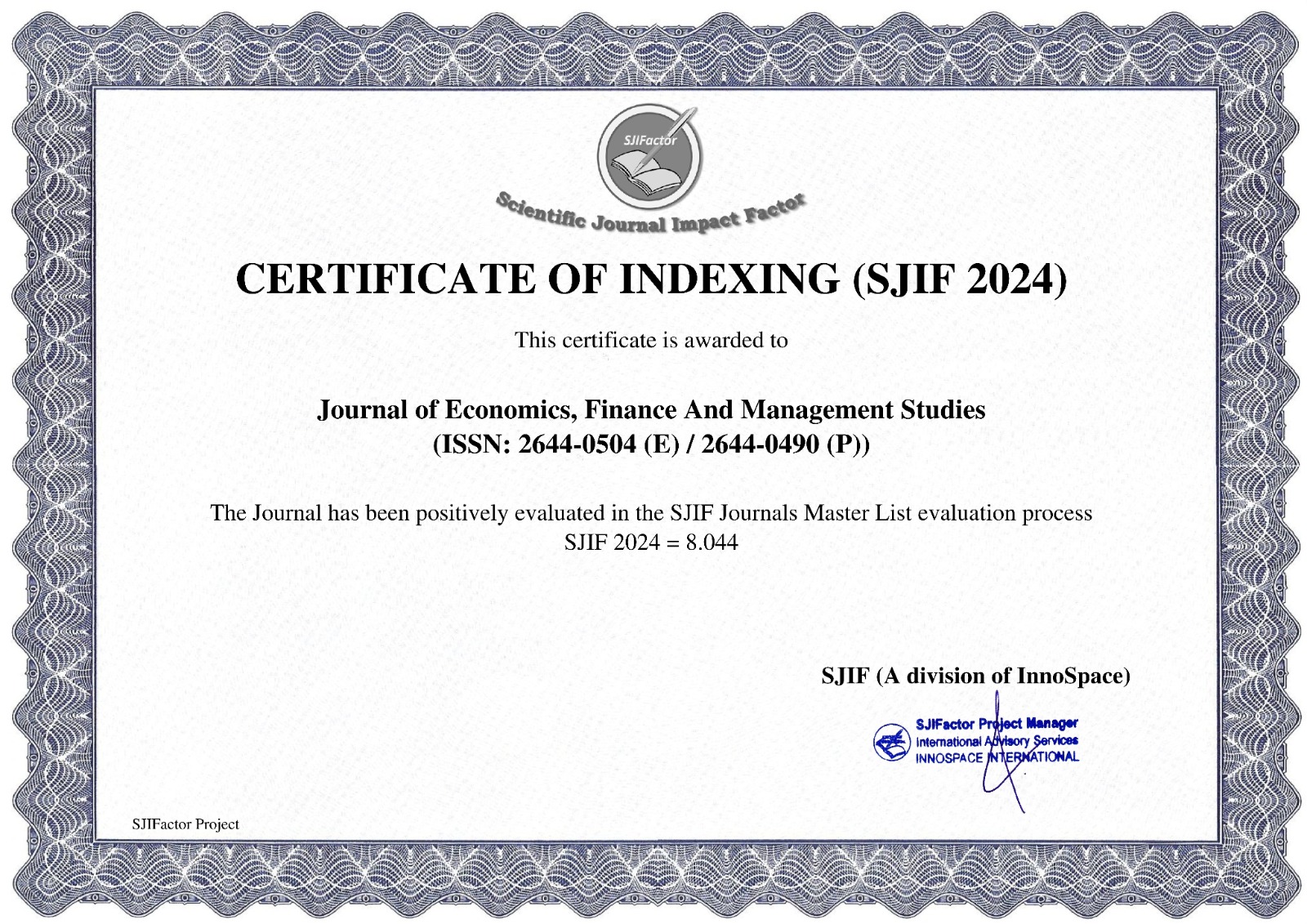Shifting Cultivation and Strategies to Cope with Food Scarcity of Ethnic Minorities in Nghean province, Vietnam
1Tran Xuan Minh,2 Nguyen Thi Tieng
1,2,Institute of Agriculture and Natural Resources, Vinh University, 182 Le Duan, Vinh City 43108, Nghean, Vietnam
https://doi.org/10.47191/jefms/v4-i6-05ABSTRACT:
Shifting cultivation is still an important form of agricultural production and is suitable for mountainous areas. To ensure food security and improve the lives of mountainous residents, it is necessary to have active swidden management measures based on local experience and technical advances to exploit land resources effectively and sustainably. This paper concludes that an effective shifting cultivation control strategy would require (1) Changes in awareness, farming practices and customs of local people; (2) Changes in policy institutions such as granting land ownership rights to shifting cultivators, linking shifting cultivation areas with local and regional market centres through infrastructure development, and provision of necessary support services such as extension, credit and marketing.
KEYWORDS:
Coping strategies, Food scarcity, Shifting cultivation, Swidden agriculture, Nghean (Vietnam)
REFERENCES:
1) Alegre, J.C. and Cassel, D.K. 1996. Dynamics of soil physical properties under alternative systems to slash-and-burn.
Agriculture, Ecosystem and Environment, 58: 39-48.
2) Atal, Y. and Bennagen, P.L. 1983. In swidden cultivation in Asia, Vol. 2, Country Profiles: India, Indonesia, Malaysia,
Philippines, Thailand. UNESCO Regional Office for Education in Asia and the Pacific: Bangkok.
3) Aweto, A.O. 2013. Shifting cultivation and secondary succession in the tropics. Wallingford, UK: CABI, pp.196.
4) Baker, R. 1984. Protecting the environment against the poor. Ecologist, 14: 53-60.
5) Brady, N.C. 1996. Alternatives to slash-and-burn: a global imperative. Agriculture, Ecosystem and Environment, 58: 3-
11.
6) Crains, M. 2015. Shifting cultivation and environmental change: indigenous people. Agriculture and Forest
Conservation, London: Earthscan.
7) Do, D.S. 1996. Overview of migration agriculture in Vietnam. Vietnam Academy of Forestry, Forestry Science and
Technology Information, 5(1): 34-39.
8) Gafur, A., Borggaard, O.K., Jensen J.R. and Peterson, L. 2000. Changes in soil nutrient content under shifting cultivation
in the Chittagong Hill Tracts of Bangladesh. Danish Journal of Geography, 100: 37-46.
9) Gafur, A., Jensen, J.R., Borggaard, O.K. and Peterson, L. 2003. Run-off and losses of soil nutrients from small watershed
and shifting cultivation (Jhum) in the Chittagong Hill Tracts of Bangladesh. Journal of Hydrology, 274: 30-46.
10) Geertz, C. 1963. Agricultural involution: the processes of ecological change in Indonesia. University of California Press:
Berkeley, CA.
11) Hayami, Y. and Ruttan, V.W. 1971. Agricultural development: An international perspective. The Johns Hopkins
University Press: Baltimore, MA.
12) Holscher, D., Ludwig, B., Moller, R.F. and Folster, H. 1997. Dynamics of soil chemical parameters in shifting agriculture in
Eastern Amazon. Agriculture, Ecosystems and Environment, 66: 153-163.
13) Juo, A.S.R. and Manu, A. 1996. Chemical dynamics in slash-and-burn agriculture. Agriculture, Ecosystems and
Environment, 58: 49-60.
14) Lele, U. and Stone, S. 1989. Population pressure, the environment and agricultural intensification: variations on the
Boserup hypothesis. Managing Agricultural Development in Africa Discussion Paper No. 4, World Bank: Washington, DC.
15) Mahapatra, L.K. 1983. In swidden cultivation in Asia, Vol. 1, Country profiles: India, Indonesia, Malaysia, Philippines,
Thailand, Atal Y, Bennagen PL (eds). UNESCO Regional Office for Education in Asia and the Pacific: Bangkok, 13–82.
16) Mertz, O. 2002. The relationship between length of fallow and crop yields in shifting cultivation: a rethinking.
Agroforestry Systems,55: 149-159.
17) Mertz, O., Birch-Thomsen, T., Elberling, B., Rothausen, S., Bruun, T.B., Reenberg, A., et al. 2012. Changes in shifting
cultivation systems on small Pacific islands. Geographical Journal, 178: 175-187.
18) Ney, P.H. and Greenland, D.J. 1960. The soil under shifting cultivation. Agronomy Journal, 54(3): 1-279.
19) Palm, C.A., Vosti, S.A., Sanchez, P.A. and Ericksen, P.J. 2005. Slash and burn agriculture: The search for alternatives. New
York, Columbia University Press, pp.24.
20) Peters, W.J. and Neuenschwander, L.F. 1990. Slash and burn: Farming in the third world forest. Geographical Review,
80(1): 1-85.
21) Ramakrishnan, P.S. 1984. The science behind rotational bush fallow agriculture system (jhum). Proceedings of the
Indian Academy of Science: Plant Science, 93: 379-400.
22) Rasul, G. and Thapa, G.B. 2003. Shifting cultivation in the mountains of South and Southeast Asia: Regional patterns and
factors influencing the change. Land Degradation and Development, 14(5): 495-508.
23) Robison, D.M. and McKean, S.J. 1993. Shifting cultivation and alternatives: An annotated bibliography, 1972-1989.
Journal of Tropical Ecology, 9(2): 1-152.
24) Ruthenberg, H. 1980. Farming systems in the tropics - 3rd edition. Oxford: Oxford University Press.
25) Sanchez, P.A., Palm, C.A., Vosti, S.A., Tomich, T. and Kasyoki, J. 2005. Alternatives to slash and burn. Challenges and
approaches of an international consortium. In: Palm CA, Vosti SA, Sanchez PA, Ericksen PJ, editors. Slash-and-Burn
Agriculture the Search for Alternatives. Columbia University Press. New York, pp. 3-37.
26) Schultz, T.W. 1964. Transforming traditional agriculture. Yale University Press: New Haven, CN.
27) Spencer, J.E. 1966. Shifting Cultivation in Southeastern Asia. University of California Press: Berkeley, CA.
28) Turner, B.L. and Brush, S.B. 1987. Comparative farming systems. Guildford Press: New York, NY.
29) Vongvisouk, T., Mertz, O., Thongmanivong, S., Heinimann, A. and Phanvilay, K. 2014. Shifting cultivation stability and
change: Contrasting pathways of land use and livelihood change in Laos. Applied Geography, 46: 1–10.
30) Vosti, S.A. and Witcover, J. 1996. Slash-and-burn agriculture-household perspectives. Agriculture, Ecosystem and
Environment, 58: 23-38.
31) Watson, D.J. 1989. The evolution of appropriate resource management systems. In Common Property Resources:
Ecology and Community-Based Sustainable Development, Beres FT (ed.). Belhaven: London: 55-69.
32) Watters, R.F. 1971. Shifting cultivation in Latin America. Food and Agricultural Organization: Rome.
















